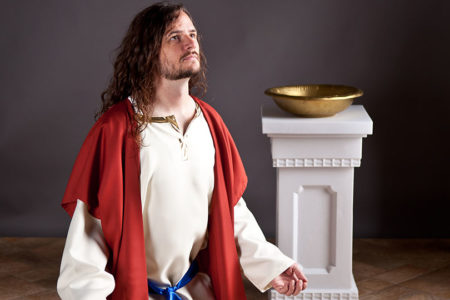Before the Silence
The 400 years between Malachi (the last Old Testament book) and Matthew (the first New Testament book) are called the Intertestamental Period. Many Christians know little about this time because it is shrouded in silence as to a revelatory Word from God. To properly understand how Israel relates to this era, it is necessary to study the nation’s postexilic history from 539 to 400 B.C.
Repatriation of Israel
In 539 B.C., Babylon fell to the Persian Empire under the reign of King Cyrus. One year later, Cyrus freed the Jewish exiles and decreed they could return to Jerusalem and rebuild their Temple (2 Chr. 36:22–23; Ezra 1:1–2). In 537 B.C., Zerubbabel led the first group home to Jerusalem. Later he became the city’s governor (Ezra 2:2; Neh. 7:7; 12:1; see also Haggai and Zechariah).
Under his able leadership, 49,897 exiles returned (Ezra 2:64–65; Neh. 7). Upon their arrival, work to restore the altar and the Temple’s foundation began (Ezra 3:2).
Soon afterward, a group of Samaritans successfully petitioned Persian King Artaxerxes to shut down construction, and the work on the Temple ceased for 16 years (4:24).
In 520 B.C., the prophets Haggai and Zechariah inspired the Jewish people to resume rebuilding. King Darius I granted permission to restart the project, and the Temple was completed in 515 B.C. (6:15), beginning what is commonly called the Second Temple Period.
In 486 B.C., Xerxes I (Ahasuerus) ascended to the Persian throne, and seven years later he chose Esther to be his queen (Est. 2:17). The events recorded in the book of Esther took place between the Israelites’ first and second returns to Jerusalem.
During Ahasuerus’ reign, a wicked Persian official named Haman nearly destroyed the Jewish people because he hated one Jewish man named Mordecai (3:7–15). At that time, all the Jews in the world lived within the vast boundaries of the Persian Empire.
In 474 B.C., Queen Esther exposed Haman’s plan. In the end, Haman was hung on the gallows he had constructed for Mordecai (chaps. 5—7), and Ahasuerus let Queen Esther issue a counter decree giving the Jewish people the right to defend themselves (8:9–12). So the Jewish people defeated their enemies, and the Feast of Purim was established in 473 B.C. to celebrate this great victory (chap. 9).
In 457 B.C., Ezra led the second expedition back to Jerusalem. This time 1,758 Jewish exiles returned, with permission from Persian King Artaxerxes Longimanus.
Ezra was a highly respected priest and scribe whose mission was to teach the “Law of the Lᴏʀᴅ” to the Jewish returnees (Ezra 7:10). Arriving in Jerusalem, he was shocked to hear how the people, priests, and Levites had married heathen women and adopted their pagan religion.
Along with other Israelites, Ezra publicly mourned over this dreadful situation and interceded for the nation, calling on God to forgive the Jewish people their sins and spare the returning remnant from His wrath. He then led the nation to repent and convinced the men to divorce their heathen wives, demanding they send both them and their offspring back to their own countries. Within 90 days, all the marriages were dissolved (chap. 10).
In 445 B.C. Nehemiah took the third group of exiles back to Jerusalem to rebuild the city’s walls, a job he accomplished in 52 days despite great opposition (Neh. 6:15). Under Nehemiah’s leadership, revival came to the land; and Judah repented of its sins.
Nehemiah reestablished the Feast of Tabernacles and ratified a renewal of the Mosaic Covenant (chaps. 8—10). Jerusalem was repopulated and its walls rededicated, and Temple responsibilities were reassigned to the priests and Levites (chaps. 11—12).
After governing Jerusalem for 12 years, Nehemiah returned to Susa in 432 B.C. to tell King Artaxerxes Longimanus of his accomplishments (13:6). In 420 B.C., he returned to Jerusalem because Israel had again fallen into sin. He reformed Temple worship, stopped the profaning of the Sabbath, and again annulled Jewish marriages to pagan women (chap. 13).
Rebellion of Israel
The Old Testament revelation closes with a final message from the prophet Malachi, who ministered either after Nehemiah returned to Susa or during Nehemiah’s second visit to Jerusalem. The book of Malachi has 55 verses, of which 47 are directly from God.
Malachi opened his revelation by declaring God’s unconditional love for an elect Israel—a love the nation continually questioned, doubted, and mocked with insensitivity and indifference. The prophet confronted Judah on many issues:
- The priests profaned God’s name and worship of Him by offering polluted, defective sacrifices in the Temple.
- Men broke their marriage covenants by divorcing their Jewish wives to become unequally yoked with pagan women, a sin Ezra had previously corrected.
- Israel robbed God of what was rightfully His by not paying their tithes and offerings to the Temple.
- The Israelites committed hypocrisy by pretending to live for the Lord while practicing wickedness. Seeking to touch their hearts, Malachi asked them a series of questions from God. But instead of acknowledging their sin, they responded with arrogance, surprise, and indifference, basically asking, “How has God loved us? And how have we despised, profaned, wearied, robbed, or spoken against God?”
Reminder to Israel
Malachi closes the Old Testament with God’s severe word of judgment (Mal. 4)—very appropriate given Israel’s continual sin and rebellion against Him. The final word Israel heard from God’s Holy Scriptures was curse: “Lest I come and strike the earth with a curse” (v. 6).
Failure to heed God’s warning would result in a curse. The word for “curse” is different from the one previously used (2:2; 3:9). It means to “ban” or “set apart under a ban” for utter extermination. A person, city, or thing could be put under such a curse, as were the Gentile cities Joshua destroyed (Dt. 13:12–15). If repentance were not forthcoming, Judah would be cursed and set apart for extermination.
Because Malachi ends with a curse, Jewish scholars during the Middle Ages repeated 4:5 after reading 4:6 so that the last words on their lips would not be a curse on their people.
Yet the curse was there for a reason: People usually remember the last words they read. The Israelites were to remember that their refusal to obey God would result in judgment. However, they could be delivered by repenting of their sin and being reconciled to God.
Malachi’s message was the final, authentic revelation from God until John the Baptist shattered the 400 years of silence with “Repent, for the kingdom of heaven is at hand!” (Mt. 3:2).
By 400 B.C., the Persian Empire was starting to wane. In the coming years, Greece, Syria, Egypt, and Rome would rise to power and severely oppress Judah in the era commonly identified as the Intertestamental Period.








persian king artaxerxes ascended to the throne prior to the book of malachi being authored 464-424 daniel chapter 11 gives detail before the 400 years of silence, also the last years of the 400 years of silence emmanuel-jesus matthew 1;23 was begotten,herod was the client indumesn -edomite king of judea-a roman vassal, which was the herodian period,alexander the great swept across the earth like an irrestible flood an was poisoned by my perspective an we must not forget the hasmonean era or there grandfather matthaias and judas an the seleucids an the ptolemies